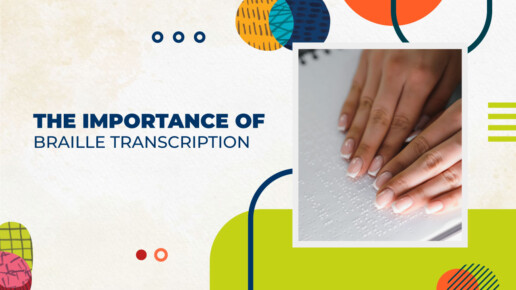The Importance of Braille Transcription
In a world that relies heavily on visual information, it is crucial not to overlook the needs of visually impaired individuals. Braille transcription plays a pivotal role in bridging the gap for those with visual disabilities, providing them access to written content and empowering them to lead independent and fulfilling lives. In this Blog, we will delve into the Importance of Braille transcription and how it positively impacts the visually impaired community.
- Understanding Braille
Braille is a tactile writing system used by individuals with visual impairments. It consists of raised dots arranged in various patterns, representing letters, numbers, and punctuation. The system allows blind individuals to read and comprehend written information through touch. Understanding Braille is essential in appreciating the importance of Braille transcription.
- Accessibility and Inclusivity
Imagine a world where printed materials are the only means of communication, shutting out those who cannot see. Braille transcription breaks down these barriers, making printed information accessible to visually impaired individuals. By providing Braille versions of books, documents, and other materials, we create a more inclusive society, where everyone has equal opportunities to learn and grow.
- Educational Advancement
Education is the foundation for personal and professional growth. Braille transcription enables visually impaired students to participate fully in the educational system. With Braille textbooks and learning materials, visually impaired students can engage with the same content as their sighted peers. This empowerment leads to better educational outcomes and opens doors to future success.
- Independence and Empowerment
For visually impaired individuals, Braille transcription is synonymous with independence and empowerment. It allows them to access essential information without relying on sighted assistance continually. Whether it’s reading a restaurant menu, a medication label, or a public notice, having Braille versions ensures independence in daily activities.
- Employment Opportunities
Equal access to information is not only essential for education but also for employment. Braille transcription makes it possible for visually impaired individuals to pursue various career paths. With access to Braille materials related to their profession, they can stay informed, acquire new skills, and advance in their careers.
- Communication and Social Interaction
Braille transcription fosters better communication and social interaction for the visually impaired. By having access to written materials, they can actively participate in discussions, exchange ideas, and stay informed about current events. This inclusion enhances their overall quality of life and strengthens social bonds.
- Navigating Public Spaces
Public spaces can be challenging for visually impaired individuals without proper signage and information. Braille transcription on signs, maps, and other informational materials in public places facilitates independent navigation. It enables them to move confidently and safely in unfamiliar environments.
- Preserving Literature and Culture
Literature and cultural heritage are vital aspects of any society. Braille transcription plays a crucial role in preserving and promoting the literary and cultural heritage of visually impaired individuals. By transcribing classic works and cultural materials into Braille, we ensure that they can experience and appreciate these valuable contributions.
- Braille and Technology
With the advancement of technology, Braille transcription has evolved as well. Braille displays and electronic Braille devices have made it easier for the visually impaired to access digital content. These technological innovations further enhance their independence and integration into the digital age.
- Advocacy and Awareness
Creating awareness about the importance of Braille transcription is essential. Advocacy efforts can lead to more inclusive policies and practices, ensuring that visually impaired individuals have access to Braille materials in various aspects of life. By amplifying the significance of Braille, we can collectively build a more inclusive and empathetic society.
Conclusion
Braille transcription is far more than a translation of written text into tactile dots. It is a powerful tool that opens doors, breaks barriers, and empowers visually impaired individuals to lead meaningful lives. By recognizing the importance of Braille transcription and promoting its integration into various aspects of society, we take a significant step towards creating a world that is truly inclusive, where everyone can participate, learn, and thrive. Let us embrace Braille transcription as a symbol of equality and accessibility for all.

